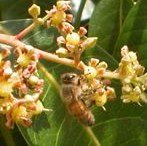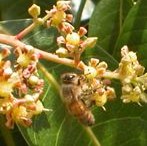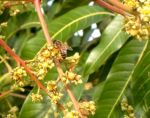
© Richie Gerber
By Richie Gerber
Can you guess the connection between Bees and Headaches? Most people can’t. Here is my first hint: aspirin. Can you now guess the connection? Probably not so here my second hint: Bayer. Still don’t know? Then here is the final giveaway hint which will make the connection obvious, neonicotinoids? Clothianidin aka Poncho® ? Imidacloprid aka Gaucho®? Humm…not as easy as I thought.
Give up? Here is what Bees and headaches have in common. Bayer, you heard me correctly. Bayer, the aspirin people with global sales of $45 billion, owns a subsidiary call Bayer CropScience AG that manufactures herbicides, fungicides, and insecticides (mentioned above) as well as treated seeds. CropScience alone does $8.8 billion in global sales that is about 20% of Bayer’s business. The EPA in a fact sheet issued 5/31/2003 has described Bayer’s Clothiantin, one of who’s trade names is Poncho® a pesticide from Bayer’s CropScience division, as follows: “ Poncho® is highly toxic to honey bees on an acute contact basis (LD50 > 0.0439 µg/bee). It has the potential for toxic chronic exposure to honey bees, as well as other nontarget pollinators, through the translocation of Poncho® residues in nectar and pollen. In honeybees, the effects of this toxic chronic exposure may include lethal and/or sub-lethal effects in the larvae and reproductive effects in the queen.” Is this starting to give YOU a headache? It sure is for me. It’s even worse for the bees.
In May 2008 Germany banned the use of Poncho® when German beekeepers reported loosing over 50% of their hives after a Poncho® application was linked to the deaths of millions of bees in the Baden-Württemberg region. Bayer responded that the toxic effect was an isolated incident caused by an “extremely rare” application error. So Poncho® is banned in Germany where Bayer was founded in 1863 and has its global headquarters. After the “extremely rare” application error people started to link Poncho®with Colony Collapse Disorder (CCD). CCD has been ravaging bee populations and nobody knows its cause. Beekeepers thought they had the smoking gun.
So why does the EPA still allow the use of this insecticide in the US even though they described it in 2003 as “highly toxic to honeybees”? And why does the EPA still allow the use of this insecticide when its use has been banned in Germany where Bayer was founded 146 years ago, and has its global headquarters? Sure beats me. The EPA issued a Press Release on 7/1/08 stating its position on the subject. They state, “EPA believes this incident in Baden-Württemberg is not related to CCD. Although pesticide exposure is one of four theoretical factors associated with CCD that the United States Department of Agriculture is researching, the facts in this case are not consistent with what is known about CCD.” So for this specific incident the EPA does not see a connection between Poncho® and CCD. I am fine with their position that for this specific incident Poncho®, a “highly toxic” pesticide to bees, caused widespread bee deaths and that the Baden-Württemberg incident was not consistent with CCD. OK, I’ll buy that.
Then in August 2008 the nonprofit Natural Resources Defense Council (NRDC) filed a lawsuit in federal court to force the EPA to disclose studies of the effect of Poncho® on honey bees. They believe that the EPA has evidence of the link between CCD and pesticides, which it has not made public. So far the EPA has not responded to the NRDC’s request for information. This is quite strange indeed. It appears to me that “everybody’s got something to hide except for me and my monkey”.
Numerous theories have been floating around regarding the cause of CCD but none has been proven. Some of the challenges facing bee populations are: parasites such as Varroa mites, bacterial or fungal disease, commercialization and industrialization of beekeeping, pesticides, insecticides, fungicides, herbicides, climate and more. I believe that it may be a combination of several or all of these factors as well as others we do not even know about at this time.
I always told my Maine neighbors as well as my Bread of Life customers, I try not to eat food that has been treated with stuff whose instructions are: wear a long sleeve shirt and long pants, gloves, hat and respirator. Do not inhale or get in contact with skin or eyes. Then they dump this stuff on their food and EAT it. No way Jose!!! But those are pretty much the instructions for the application of Poncho®.
Epp-BEE-Log: I think the name Poncho® for an insecticide is cool. That is why I used it so much in this article. Great marketing! The EPA needs to redouble its efforts to analyze many of the substances on the market to see if they are part of the CCD problem. Maybe it might be a combination of chemicals. Maybe one farmer is applying chemicals while a nearby field is being pollinated. The EPA must also release any and all information on chemicals that are being applied to our food so we can see what is going on. All I can say to the EPA is, take two aspirin and call me in the morning!

 It happens to me every time I go to a party or gathering with Julie. Someone always brings up some permutation of an issue regarding the alternative lifestyle in order to, “pick my brain”. I guess these issues are all over the media, making people wonder about them. That’s great. At a recent gathering I was surrounded by several couples that wanted my point of view. They wanted to know which produce, local or organic, was better for the environment. The discussion heated up very quickly as I realized I was being ambushed. They were all Local Yokels and I am an Organic Fanatic.
It happens to me every time I go to a party or gathering with Julie. Someone always brings up some permutation of an issue regarding the alternative lifestyle in order to, “pick my brain”. I guess these issues are all over the media, making people wonder about them. That’s great. At a recent gathering I was surrounded by several couples that wanted my point of view. They wanted to know which produce, local or organic, was better for the environment. The discussion heated up very quickly as I realized I was being ambushed. They were all Local Yokels and I am an Organic Fanatic.









